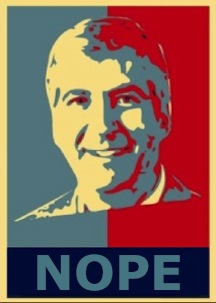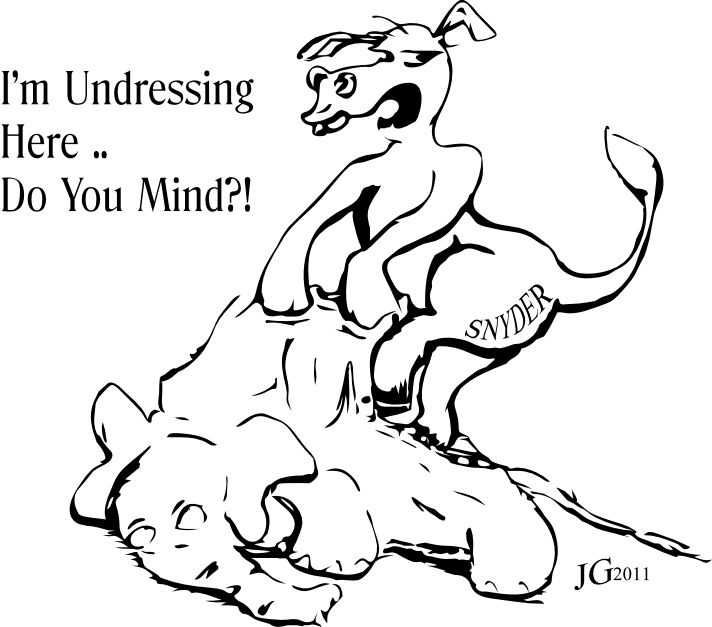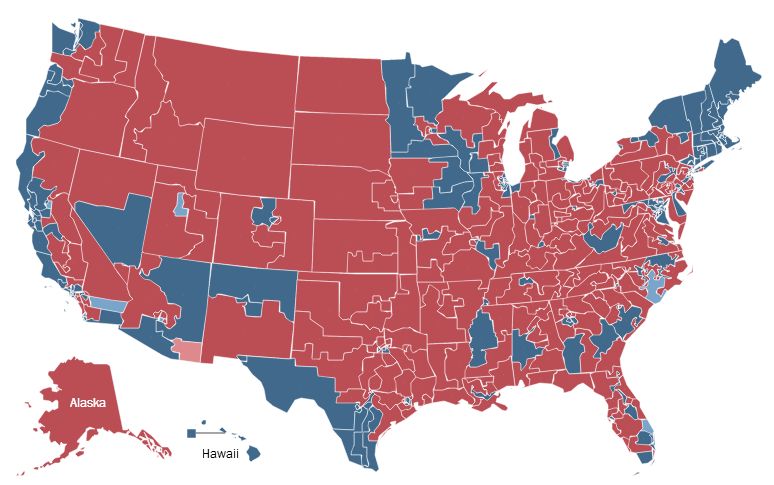
 |
NAVIGATION
|
NEWS TIPS!RightMichigan.com

Who are the NERD fund donors Mr Snyder?Tweets about "#RightMi, -YoungLibertyMI, -dennislennox,"

 |
The District Method - History and ExplanationBy Kevin Rex Heine, Section News
You may have heard of the National Popular Vote Interstate Compact, an initiative being advanced by a Soros-funded group that intends to bypass the Constitution and obviate the Electoral College, handing the quadrennial presidential elections to whomever wins the plurality of the nationwide popular vote. This article isn't the place to go into the details of the initiative (the link provides a usable starting point for further research), but suffice it that triggering the compact will realize something that has been a strategic objective of the progressives for quite some time.
However, America is not a democracy; rather, the United States are a republic. And that distinction isn't one of mere semantics. In a republic, the voice of the people is more indirect the more non-local the matter is. When it comes to elections, I can think of none more non-local than the presidential election. Among the checks and balances the Founding Fathers included in the Constitution was the balance of the voice of the people with the voice of the states, thus the use of the Electoral College to elect the president every four years.
More specifically, or perhaps more generally, the Founders also intended that the voice of the people in all federal matters would be realized through their congressional districts (senators were never intended to be popularly elected), thus the reason that the members of the House of Representatives must all stand for reelection every two years. In theory, the people would be paying attention to what their elected representation is doing, and call them to account if they're screwing up. Granted, that hasn't been the case much of late, but that isn't the Founding Fathers' fault. With regard to the presidential elections (though each state was empowered to make its own decision), the original intention was that the states would use the District Method to handle their Electoral College representation, and thirteen states have at one time or another used some variant of the district method to allocate their electoral votes (Maine and Nebraska still do).
The District Method of allocating presidential electors comes in two basic variants, the Electoral District Method and the Congressional District Method. Electoral District Method - This method involves dividing the state into electoral districts (congressional districts plus two), and was the original design envisioned by James Wilson of Pennsylvania in his proposal to the Federal Convention. By this method, voters in each district would cast their ballots for the candidate they supported and the winner in each district would receive that electoral vote. Tennessee's original implementation of this method involved each county choosing an electoral delegate by popular vote, and then the county delegates meeting at a district conference to cast their votes for president. After 1832, the only time that this method was used was in the 1892 election, when Michigan's (then Democrat-controlled) Legislature successfully split the state's electoral vote (5 votes for Grover Cleveland, 9 votes for Benjamin Harrison). The chief drawback to the Electoral District Method is that these are special-use districts that will be used, literally, only two or three times before the next census, and have no function whatsoever outside the quadrennial presidential elections. Congressional District Method - Under the Congressional District Method, the electoral votes are distributed based on the popular vote winner within each of the state's congressional districts; and the two at-large votes (representing the two votes each state receives in the U. S. Senate) are apportioned in any manner the state legislature sees fit to implement. Currently, only Maine and Nebraska use the Congressional District Method for distributing their electoral votes, and they both opt to assign their at-large votes to the winner of the statewide popular vote. However, there are other options for the two at-large votes that have been used or are being considered:
Andrew Jackson has the unique distinction of being the only presidential candidate to finish with the most electoral votes at the Meeting of the Electors, and yet lose the election. This is because the 99 votes Jackson received from the 1824 Electoral College were 32 short of the 131 votes needed for majority (as the Constitution specifies). That he also received the plurality of the nationwide popular vote (151,271 ÷ 365,833 ≈ 41.35%) is irrelevant for two reasons: First, six states (DE, GA, LA, NY, SC, & VT) used the Legislative Appointment Method of awarding their presidential electors, so the popular vote total excludes those states. Second, as I've observed before, the Founding Fathers repeatedly rejected the "popular election method" for the national executive, so the popular vote tally is irrelevant except as a statistical footnote. Nevertheless, the fact that Jackson had received both pluralities gave the Senator from Tennessee the reasonable expectation that he would win the Contingent Election in the House of Representatives. However, Henry Clay, the Speaker of the House, a known ally of Secretary of State John Quincy Adams (and known to personally dislike Jackson), placed his support behind Adams, bringing the three states that he'd carried in the Electoral College (KY, MO, & OH) with him. He also apparently convinced the congressional delegations of Illinois, Louisiana, and Maryland to flip their votes, thus securing a 13-7-4 bare-majority win for Adams on the first ballot. Predictably, Old Hickory was furious, claiming that the people had been cheated of their choice because of a corrupt bargain, and spent the next four years campaigning for a rematch with Adams, including convincing many states to switch their presidential elector selection method to "winner take all, at large popular vote" (though notably New York used the Congressional District Method for the only time in the 1828 election). By the time that Jackson left office in 1837, every state except South Carolina had adopted the democratic reform, and the District Method faded from the scene. Now, however, the RNC is advancing an initiative in at least six states (FL, MI, OH, PA, VA, and WI) to move them to one variant or another of the Congressional District Method, both to put a dent in the DNC's perpetual 56 EV head-start every quadrennium and to erect a "swing-state firewall" against the National Popular Vote initiative, which the RNC unanimously denounced a couple of years ago. Predictably, the left (such as Slate, Huff-Po, Wa-Po, and B4M) is screaming foul, though USA Today, to its credit, took an official editorial position opposed to the NPV initiative (the opposing view advocating the NPV is here). But again, those who honestly believe that the National Popular Vote Compact is the "more principled way" to reform the "antiquated" Electoral College are likely the same fools who honestly believe that America is a democracy, and that President Obama has widespread popular support because of his Electoral College margin of victory of 126 votes and his popular vote margin of 4,970,508 (never mind that BHO only carried three more jurisdictions than WMR did or that the popular vote difference amounts to about a 3.91% separation). The question we ought to be asking is: What did the people's voice really say in the 57th quadrennial presidential election? And in order to figure that out, we need to know what the Electoral College map would have looked like if every state ≥ 4 EV used the Congressional District Method for allocating their electoral representation. That's the research project I've been armpit-deep in for the past seven weeks (with the assistance of the iCaucus Election Integrity Project). I've been going through all 43 multi-district states to see how the 2012 presidential vote broke down by district. Some states were easy to sort out (or already had it sorted out for me), and some others are being a tad problematic. I've been keeping tabs on the Daily Kos' crowdsourced project, and between their data and the data that I've verified against official records, I've accounted for 513 electoral votes so far (about 95.35% of the entire college). Just for the record, I'm also independently verifying states that the Kos has listed as completed, because I've noticed that their supporting data is suspect, though they've yet to misassign an electoral vote. I haven't yet established a "winner" for this election (Romney has 266 EV, and Obama has 247), but I am down to seven states that, if I can complete them before the Daily Kos does, I'll run with a preliminary report in a heartbeat if I think the Kos is getting too close to completion for comfort. However, I'm not going to publish a final report until I've verified the results from each congressional district, as I'm something of a stickler for making sure that the numbers can stand up to detailed scrutiny. My original intent was to have this report done by Friday (January 18th), so that it could have been published over the weekend and perhaps received some news coverage during the inaugural pomp-and-circumstance. However, as I'm clearly not going to make that deadline, I've adjusted the deadline to February 8th (the Friday before the SOTU address), though I intend to finish earlier if that can be done. If I'm right in that more congressional districts went for Romney than for Obama (still an open question), then this will be a direct rebuke of the notion that Obama governs with widespread popular support. The peoples' voice, properly understood, would argue otherwise, and I suspect that it'll look much like the congressional results from last November.

The District Method - History and Explanation | 8 comments (8 topical, 0 hidden)
The District Method - History and Explanation | 8 comments (8 topical, 0 hidden)
|
Related Links+ National Popular Vote Interstate Compact+ thirteen states have at one time or another used some variant of the district method + Electoral District Method + 1892 election + Congressio nal District Method + New York used a modified form of the Congressional District Method + currently debating an implementation + 1824 election + Andrew Jackson + 99 votes Jackson received from the 1824 Electoral College + Legislativ e Appointment Method + as I've observed before + Henry Clay + John Quincy Adams + thus securing a 13-7-4 bare-majority win for Adams + corrupt bargain + 1828 election + Slate + Huff-Po + Wa-Po + B4M + took an official editorial position opposed to the NPV + the opposing view advocating the NPV is here + Daily Kos' crowdsourced project + Also by Kevin Rex Heine |